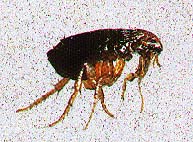|
FLEA, TICK & HEARTWORM CONTROL
Successful flea control involves:
- Eliminating fleas from ALL cats in the family
- Controlling fleas in the HOME and YARD environment
When it comes to environmental control in the house and yard, we must first understand the flea life cycle.
There are four stages in the life cycle of the flea.
- Flea eggs are whitish and about 0.5 mm (1/32”) in length. They are unlikely to be seen without a magnifying glass. The adult flea lays eggs after taking a blood meal. The eggs are initially laid on the pet’s skin but fall off into the environment to continue their life cycle. Flea eggs constitute approximately 50% of the total flea population. Eggs may hatch in as little as 14 to 28 days, depending on environmental conditions. High humidity and temperature favors rapid hatching.
- Flea larvae are about 2-5 mm (1/8 to ¼”) in length. They feed on organic debris and adult flea feces found in their environment. They dislike strong light and move deep into carpet fibers or under furniture, organic debris, grass, branches, leaves, soil, etc. Flea larvae prefer warm, dark and moist areas. Outdoor larval development occurs only in shaded; moist areas where flea infested pets spend a significant amount of time. Our climate controlled homes offer an ideal environment for the flea life cycle to thrive.
- The flea pupae produce a protective silk-like cocoon, which is sticky. It quickly becomes coated with grime and debris, which acts as a useful camouflage. With warmth and humidity, pupae become adult fleas in 5-10 days. The adults do not emerge from the cocoon unless stimulated by vibrations, physical pressure, carbon dioxide or heat. This is important since once fleas emerge from the cocoon they can only exist for a few days unless they are able to feed. Pre-emerged adult fleas can survive within the cocoon for up to 9 months. During this time they are resistant to insecticides applied to the environment. This is important to remember because adult fleas may emerge into the environment a considerable time after insecticides are applied in the home. This is why we recommend vacuuming. This may remove some of the pupa stage from the environment but also stimulates the pupa to hatch and come in contact with the environmental treatment products.
4. Once emerged the flea adult, unlike the larvae, is attracted to light and emerges to the surface in order to encounter a passing host to feed upon. The female flea needs to feed within 2 days of hatching and she will not start to lay eggs until 2 days after she has her first meal. This is where using Capstar every 2 days in the beginning of the treatment helps. In normal circumstances the adult female will live up to three weeks, laying approximately 40-50 eggs per day. One female can lay over 3,000 eggs in 3 weeks. The entire life cycle, from egg to adult flea can be completed in 14-28 days depending on environmental conditions. Adult fleas can jump 6-8 feet.
Products we recommend for use on Cats:
Revolution–
(For Cats)
* Applied topically, absorbed systemically.
* Kills adult fleas and ticks (American dog tick)
* Prevents flea eggs from hatching.
* Works for up to 30 days.
Cats – 8 weeks of age or older– also prevents Heartworm Disease, Hookworms, Roundworms and Ear mites.
Advantage Multi–
(For Cats)
* Applied topically, absorbed systemically.
* Kills adult fleas before they lay eggs.
* Works for up to 30 days.
Cats -- 9 weeks of age or older and more than 2lbs.—also prevents Heartworms Disease, Hookworms, Roundworms, and Ear mites.
Capstar – (Nitenpyram)
(ForCats)
* Starts working in 30 minutes.
* Kills 90% of fleas in 6 hours.
* Only works for 24 hours.
Cats -- 4 weeks of age and at least 2 pounds.
Virbac ® Ecto-Soothe®3X – 0.15% pyrethrin content – shampoo for fleas and ticks
Environmental Products:
House:

Knock Out by Virbac
* Kills adult fleas and ticks and controls larvae for up to 120 days.
* Vacuum first to stimulate the pupae to hatch
Yard:

Yard Spray by Virbac – use monthly.
* Kills adult fleas and ticks.
Diseases/Problems fleas can cause:
- Anemia – puppies and kittens can die from a significant blood loss caused by a large number of fleas
- Tape worms – an intestinal parasite
- Pruritus – Itching
- Flea bite dermatitis is the most common skin problem in cats and dogs
- Flea Allergy – this is a true allergic reaction to fleas. It only takes one flea bite to make these pets itch for days. Strict environmental control is necessary to help these pets.
Fleas make it difficult to diagnose and treat other causes of itching (pollen allergies and food allergies).
| 






